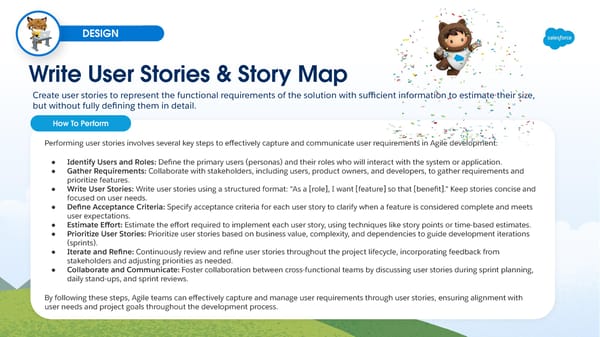2 DESIGN Write User Stories & Story Map Create user stories to represent the functional requirements of the solution with sufficient information to estimate their size, but without fully defining them in detail. How To Perform Performing user stories involves several key steps to effectively capture and communicate user requirements in Agile development: ● Identify Users and Roles: Define the primary users (personas) and their roles who will interact with the system or application. ● Gather Requirements: Collaborate with stakeholders, including users, product owners, and developers, to gather requirements and prioritize features. ● Write User Stories: Write user stories using a structured format: "As a [role], I want [feature] so that [benefit]." Keep stories concise and focused on user needs. ● Define Acceptance Criteria: Specify acceptance criteria for each user story to clarify when a feature is considered complete and meets user expectations. ● Estimate Effort: Estimate the effort required to implement each user story, using techniques like story points or time-based estimates. ● Prioritize User Stories: Prioritize user stories based on business value, complexity, and dependencies to guide development iterations (sprints). ● Iterate and Refine: Continuously review and refine user stories throughout the project lifecycle, incorporating feedback from stakeholders and adjusting priorities as needed. ● Collaborate and Communicate: Foster collaboration between cross-functional teams by discussing user stories during sprint planning, daily stand-ups, and sprint reviews. By following these steps, Agile teams can effectively capture and manage user requirements through user stories, ensuring alignment with user needs and project goals throughout the development process.
 A Partner Readiness Guide to Deliver Like Salesforce Page 65 Page 67
A Partner Readiness Guide to Deliver Like Salesforce Page 65 Page 67